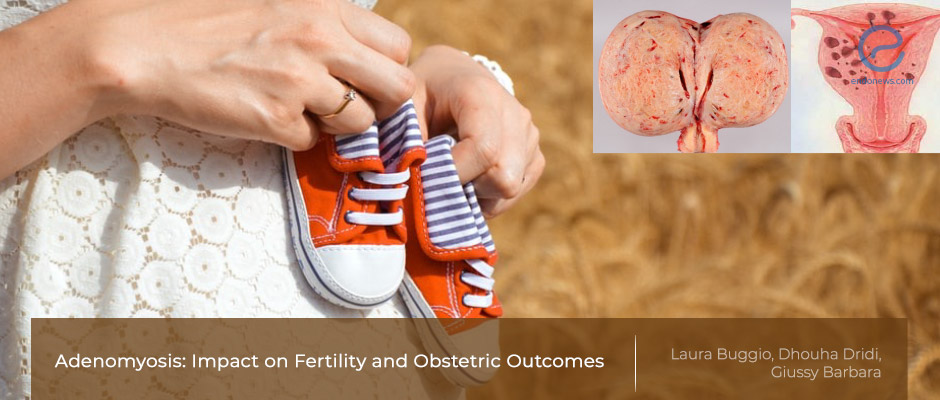Adenomyosis, fertility, and obstetric outcomes
Aug 16, 2021
Adenomyosis has a detrimental effect on fertility and obstetric outcomes
Key Points
Highlights:
- Adenomyosis has a detrimental effect on fertility and obstetric outcomes due to several proposed mechanisms
- Impaired sperm transport and implantation, uterine dysperistalsis, and the presence of abnormally high levels of free radicals in the uterine milieu are some of them.
Importance:
- Women with adenomyosis seeking pregnancy should be individually managed as to whether they should be referred to medical, surgical, or IVF treatment.
What’s done here?
- This is a commentary which evaluate the impact of adenomyosis on fertility and obstetric outcomes.
- Adenomyosis is "the localization of endometrial glands within the myometrial wall", and has a potential negative impact on fertility and obstetric outcomes.
- Imaging methods including transvaginal ultrasonography, and magnetic resonance imaging have an important place in the diagnosis.
- Magnetic resonance imaging has a higher ability to discriminate and identify adenomyosis, but transvaginal ultrasonography is cheaper, more accessible, and practical.
- Impaired sperm transport-implantation, uterine dysperistalsis, high levels of free radicals in the uterine milieu, decreased uterine wall extensibility, narrowed uterine cavity, augmented vascular resistance and increased risk of defective placentation are among the mechanisms that cause decreased fertility and poor obstetric outcomes.
- The likelihood of clinical pregnancy is decreased while miscarriage risk is increased in women with adenomyosis, especially in cases of in vitro fertilization.
- Preterm birth, baby small for gestational age, and preeclampsia were also more frequently encountered in women with adenomyosis, compared to those without adenomyosis.
Key results:
- Despite extensive research, the optimal management of adenomyosis still remains unclear.
- There is no consensus on medical or surgical treatment, or direct IVF treatment for improving fertility and obstetric outcomes.
- Gonadotropin-releasing hormone agonists, may increase the chance of embryo implantation by reducing the uterine volume and normalizing some of the distorted endometrial functions.
- Management of adenomyosis using gonadotropin-releasing hormone antagonists is still an experimental approach.
- Surgical excision of adenomyosis carries the risk of uterine rupture in women who will become pregnant in the postoperative period.
- Women with coexistent adenomyosis and endometriosis or deep infiltrating endometriosis undergoing IVF should be counseled carefully.
Lay Summary
Adenomyosis is the localization of endometrial glandular and stromal cells within the myometrial wall.
Although magnetic resonance imaging has a higher ability to discriminate and identify adenomyosis, transvaginal ultrasonography is a cheaper, more accessible, and practical method in daily clinical practice for the diagnosis of adenomyosis. There is an association between adenomyosis and fertility and obstetric problems depending on various mechanisms such as impaired sperm transport-implantation, uterine dysperistalsis, and presence of high levels of free radicals in the uterine milieu, decreased uterine wall extensibility, narrowed uterine cavity, augmented vascular resistance and increased risk of defective placentation.
Buggio et al, from Italy, published a commentary titled “Adenomyosis: Impact on Fertility and Obstetric Outcomes” in the journal "Reproductive Sciences". The likelihood of clinical pregnancy is decreased, and miscarriage risk is increased in women with adenomyosis, especially in cases of in vitro fertilization. Preterm birth, baby small for gestational age, and preeclampsia are also more frequently encountered in women with adenomyosis, compared to those having no adenomyosis.
Although there are several medical and surgical therapeutic options, the most effective treatment modality has not yet been elucidated. Gonadotropin-releasing hormone agonists and antagonists may increase the chance of implantation by reducing the uterine volume and normalizing some of the distorted endometrial functions, but are still experimental.
Total surgical removal of the disease is very important to prevent recurrences. However, surgical excision carries the risk of uterine rupture in women who will become pregnant in the postoperative period. Referring patients directly to IVF treatment is another treatment option.
“Adenomyosis negatively impacts fertility and pregnancy outcomes, particularly in terms of pre-eclampsia, preterm birth, and 'small for gestational age baby' rates,” the authors added.
Research Source: https://pubmed.ncbi.nlm.nih.gov/34231176/
adenomyosis IVF pregnancy infertility uterine rupture obstetric outcomes preterm birth pre-eclampsia MRI USG

